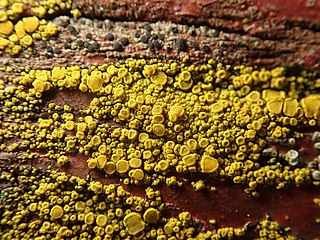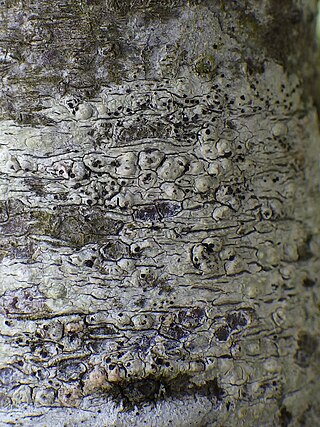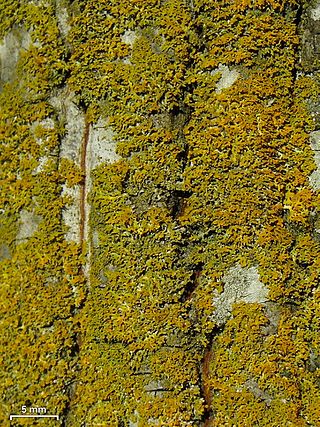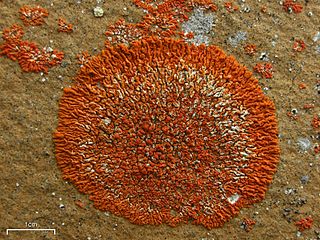
The Pertusariaceae are a family of lichen-forming fungi in the order Pertusariales.

Unguiculariopsis is a genus of lichenicolous fungi in the family Cordieritidaceae. It has 29 species.

Psoroglaena is a genus of lichen-forming fungi in the family Verrucariaceae. The genus was circumscribed by Johann Müller Argoviensis in 1891, with Psoroglaena cubensis assigned as the type species.

Candelariella is a genus of bright yellow, ocher, or greenish yellow crustose or squamulose lichens in the family Candelariaceae. Members of the genus are commonly called eggyolk lichens, goldspeck lichens, or yolk lichens. The genus was circumscribed in 1894 by Swiss lichenologist Johannes Müller Argoviensis, with Candelariella vitellina assigned as the type species.

Skyttea is a genus of lichenicolous (lichen-dwelling) fungi in the family Cordieritidaceae. The genus was circumscribed in 1981 by lichenologists Martha Allen Sherwood, David L. Hawksworth, and Brian J. Coppins, with Skyttea nitschkei assigned as the type species.
Psorotichia is a genus of lichen-forming fungi in the family Lichinaceae. The genus was circumscribed by Italian lichenologist Abramo Bartolommeo Massalongo in 1855, with Psorotichia murorum assigned as the type species.
Coppinsidea is a genus of two species of crustose lichens in the family Ramalinaceae. It was circumscribed in 2019 by lichenologists Sergey Kondratyuk, Edit Farkas, and Laszlo Lőkös with Coppinsidea sphaerella designated as the type species. Species of Coppinsidea are similar in appearance and morphology to Thamnolecania, but differ from them in having a thallus that is crustose, mostly convex to almost spherical apothecia that are lecideine or biatorine in structure, as well as in being distributed in the Northern Hemisphere.

Gallowayella is a genus of lichen-forming fungi in the family Teloschistaceae. It has 15 species. The genus was circumscribed in 2012 by Sergey Kondratyuk, Natalya Fedorenko, Soili Stenroos, Ingvar Kärnefelt, Jack Elix, and Arne Thell, with Gallowayella coppinsii assigned as the type species. The generic name honours New Zealand lichenologist David John Galloway (1942–2014).

Catillaria is a genus of crustose lichens in the family Catillariaceae. The genus was circumscribed by Italian lichenologist Abramo Bartolommeo Massalongo in 1852. It is the type genus of Catillariaceae, which was circumscribed by Austrian lichenologist Josef Hafellner in 1984.
Caloplaca kedrovopadensis is a little-known species of crustose lichen in the family Teloschistaceae. It is only found in the Kedrovaya Pad Nature Reserve in the Russian Far East, and on the Jiri Mountain of South Korea. The lichen has been recorded growing on rocks and on bark.
Biatora oxneri is a species of corticolous (bark-dwelling) lichen in the family Ramalinaceae. It is found in the Russian Far East and in South Korea.
Alfred Mycolayovych Oxner was a Ukrainian botanist and lichenologist. His research covered various areas: floristics, taxonomy, phylogenetics, phytogeography, and phytosociology. Oxner founded the National Lichenological Herbarium of Ukraine.
Klára Anna Verseghy was a Hungarian lichenologist. She was the curator of the lichen collection of the Hungarian Natural History Museum in Budapest from 1958 to 1985.
Bryostigma is a genus of lichen-forming fungi of uncertain familial placement in the order Arthoniales. The genus was circumscribed in 1979 by Josef Poelt and Peter Döbbeler, with the muscicolous lichen Bryostigma leucodontis assigned as the type species. A dozen Arthonia species were transferred into the genus in 2020 following molecular phylogenetic analysis of the family Arthoniaceae that showed distinct phylogenetic lineages that were basal to that family. The genus contains several parasitic species that occur on hosts having chlorococcoid photobionts.

Verseghya is a genus of lichen-forming fungi in the family Pertusariaceae. It has two species. The genus was circumscribed in 2016 by lichenologists Sergey Kondratyuk, Laszlo Lőkös, and Jae-Seoun Hur, with Verseghya klarae assigned as the type species. This crustose species is found in South Korea, where it grows on the bark of a wide variety of both deciduous and coniferous trees. Molecular phylogenetic analysis showed that Verseghya klarae occupied a separate phylogenetic branch in the Pertusariaceae, situated between the genera Ochrolechia and Pertusaria and the Lecanora subcarnea species complex. Verseghya thysanophora was transferred to the genus in 2019. It is widely distributed in the Northern Hemisphere.

Rusavskia is a genus of lichen-forming fungi in the family Teloschistaceae. It has 12 species. It is a member of the subfamily Xanthorioideae. The thallus of Rusavskia is characterized by its foliose (leaf-like) structure with distinct and typically narrow lobes that curve outwards.
Rusavskia indica is a species of both corticolous (bark-dwelling) and saxicolous (rock-dwelling) lichen in the family Teloschistaceae. Found in India, it was formally described as a new species in 2017 by lichenologists Sergey Kondratyuk and Dalip Kumar Upreti. The type specimens were collected in Jammu-Kashmir.
Orientophila is a genus of lichen-forming fungi in the family Teloschistaceae. It has 15 species of mostly saxicolous (rock-dwelling), crustose lichens. All Orientophila species occur in Northeast Asia including China, Japan, South Korea, and the Russian Far East.
Franwilsia is a genus of lichen-forming fungi in the family Teloschistaceae. It has three species.
Oxneriopsis is a genus of lichen-forming fungi in the family Teloschistaceae. It has four species of corticolous (bark-dwelling), crustose lichens.









